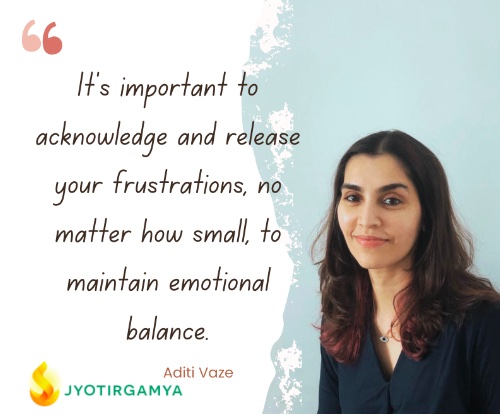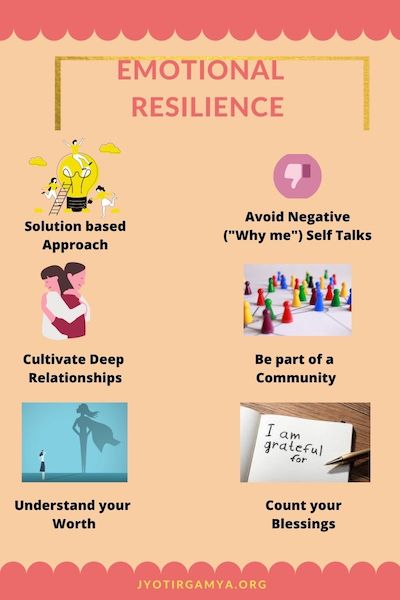Don't Stress, Stress : A Therapist's Perspective
Two young women used to travel together on the train to their college, and during the hour-long journey, they would chat about anything and everything. One evening, on the way back home, one seemed down, and the other sensed it immediately. With care and concern, she gently coaxed her friend to open up and share her troubles. She listened patiently, asked thoughtful questions, and offered comfort without judging or interrupting. By the end of the ride, the narrator felt a weight lifted off her shoulders, and she was grateful for her friend’s support.
From that day, Aditi Vaze became known for her ability to listen deeply and empathize with others. As a result, people gravitated toward her, and she found herself as a confidant and counselor. After each conversation, people would express their gratitude and marvel at how better they felt.
Growing up, Aditi saw her parents, both doctors, help people in pain and suffering. She wanted to follow in their footsteps and serve others but in a different way. Her gift for listening and her keen intuition led her to become a therapist with over a decade of experience.
In the early days of her career, therapy was not widely accepted or respected. Aditi faced many challenges and skeptics who dismissed therapy as a “pseudo-science.” But she persisted, knowing there was a science behind what she did and her work could help heal people. Today, she is proud to be part of a growing profession that values evidence-based techniques and rigorous training.

Q: Can you describe malaise, stress, and anxiety?
To explain, let’s use a scale from 0 to 10. A cow chewing cud would be a 0 while being in a panic where you can barely speak or act would be a 10. Malaise falls between 0 to 2, stress from 2 to 6, and anxiety from 7 to 10.
Malaise is a nagging discomfort that lingers in the back of your mind. You might not know the exact reason behind it, but it could be due to factors like overeating, lack of sleep, or minor issues.
Stress is a natural emotional response to the challenges of daily life. Worry, fear, anger, and sadness are normal reactions that can help us grow and improve. However, if the stress becomes too much, it can negatively impact our ability to function and cope.
Although stress is often seen as a negative emotion, it can motivate. For instance, if you are going for an exam, some level of stress can help you perform better.
When stress becomes overwhelming and leads to avoidance behaviors or feeling trapped, it can become anxiety. Both stress and anxiety can affect our thoughts and emotions, making it difficult to function normally. It’s impossible to live without experiencing stress or anxiety, but counseling can equip you with tools to manage these emotions more effectively.
Q: Where would depression fall on the same scale?
Depression is a mood disorder characterized by prolonged sadness, hopelessness, and helplessness. A person with depression may engage in negative self-talk, such as “I am useless,” “there is no getting out of this,” or “I am hopeless.”
In contrast, someone with an anxiety disorder may have a different self-talk pattern, such as “Why does this always happen to me?” “Why am I so unlucky?” or “Why do I always invite trouble?”
Q: What are some ways to deal with stress?
It’s essential to approach stress differently by reframing your mindset. Instead of being stressed about stress, acknowledge it and face the issues head-on. Avoiding stressors will drain your energy and distract you from what needs to be done.

Remember, no one is in control all the time, and coping with life’s challenges is a part of the human experience. Rejection and failure are inevitable, and thinking that things will always be easy is setting unrealistic expectations. The key is to equip yourself with effective coping mechanisms to manage stress and overcome challenges.
Q: “Mindfulness” and “Journaling” have become buzzwords, take us beyond them.
There are two types of support - prevention, and intervention. Meditation, mindfulness, and journaling require consistent effort and time. It’s like building muscle - it takes time, and results are not immediate.
When we feel like we’re driving a car without shock absorbers, seeking help without hesitation is crucial. Waiting until it’s too late can make things worse. If we need to get from point A to point B, and a bus is available, it’s better to take the faster route.
Q: How should one build one’s emotional first-aid kit?
It’s always good to have some tools handy to manage difficult emotions. The goal is to calm the panic so that our logical brain takes over from our emotional brain.
Here are some ideas to create an emotional first-aid kit:
- Smell: Use aromas like lavender or vanilla to remind you of calmness or home.
- Visual: Keep a photo of a loved one or a note of encouragement from yourself.
- Touch: Use a soft or comforting item, like a cozy blanket or a stress ball.
- Hear: Listen to music that helps you relax or uplifts your mood.
- Taste: Include a snack or a drink that comforts you, like tea or chocolate.
Remember, your emotional first-aid kit can be personalized to your needs and preferences. Creating one before you need it is essential so it’s readily available when you feel overwhelmed.
Q: When there is a fracture in the physical body, we have a straightforward course of action - medicine, physio, and time. But what about a fracture in the emotional body?
A baby won’t walk in 3 months, but only when the limbs are developed. The healing process is not a quick fix; it takes time and patience.
Kubles Ross’s model suggests that people go through 5 stages to heal.
- Denial: the state of shock that the accident could not have happened.
- Anger: How could this happen to me? Anger to yourself, those around you, and maybe even to God.
- Bargaining: if X reverts to its original state, I will do Y. Y could range from visiting a shrine to making adjustments in your behavior or giving up something you desire the most.
- Depression: Period of sadness, helplessness, and isolation.
- Acceptance: Realisation, Reorganisation, Recovery, and Restoration.
The stages might not be linear and vary from person to person. However, the process of recovery should continue.
We must witness our grief and accept stress as a part of life to heal. Being present for both the peaks and valleys of life is crucial. Each person’s grief is unique and needs to be fully witnessed without trying to point out the silver lining.
The time we spend healing can be used to make meaningful connections and create something. Having structure in our day is essential to help us through the process.
Just like a baby won’t walk in three months, we must be patient and give ourselves time to heal emotionally.
Q: Want to build emotional resilience and be more robust in adversity? Here’s how.
Emotional resilience isn’t a single-fits-all concept; everyone’s degree varies. But it’s the ability to rebound from emotional adversity that defines it. Those who seem tough on the outside may be fragile, but you can train your emotional resilience over time. Here are some drills to build emotional resilience:

- Shift your perspective: Instead of getting stuck in the problem, focus on finding a solution.
- Nix negative self-talk: Banish the “why me” and “I’m so unlucky” thoughts and replace them with positive affirmations.
- Cultivate deep relationships: Having a support system of trusted friends and family can be a massive help during tough times.
- Build community: Joining groups or clubs that align with your interests can foster a sense of belonging and connection.
- Recognize your self-worth: You’re amazing and unique, so own it! But remember to stay humble.
- Practice gratitude: Acknowledge and appreciate what you have, and you’ll see the positives in life.
Q: Feeling frustrated and need an emotional release? Try these micro-catharsis sessions with yourself.
Catharsis is a psychoanalytical concept that involves emotional release from unconscious conflicts, typically with the help of a therapist. But you don’t need to be in therapy to release your emotions. Here are some tips for holding micro-catharsis sessions with yourself:
- Move your body: Exercise releases endorphins and can help boost your mood. Dance, play music, or do any other activity that makes you happy.
- Journal your emotions: Writing down your thoughts and feelings can be therapeutic and help you process daily frustrations.
- Find a creative outlet: Paint, write, or play an instrument - whatever helps you express yourself.
Remember, taking care of your emotional well-being is essential, and these simple exercises can be a powerful way to release and process your emotions.
It’s important to acknowledge and release your frustrations, no matter how small, to maintain emotional balance.
Conclusion
In conclusion, the article emphasizes the importance of seeking help when dealing with emotional issues. It stresses the significance of therapy as a profession that values evidence-based techniques and rigorous training. The author describes the differences between malaise, stress, anxiety, and depression and provides tips on managing stress and building an emotional first-aid kit. The article encourages reframing one’s mindset and equipping oneself with effective coping mechanisms to manage stress and overcome challenges. Overall, the article promotes self-care and seeks to empower individuals to take control of their mental health.
Aditi’s gift of listening and intuition led her to become a therapist with over a decade of experience. Despite facing skeptics who dismissed therapy as a “pseudo-science,” she persisted, knowing there was a science behind what she did and her work could help people heal. Today, Aditi is proud to be part of a growing profession that values evidence-based techniques and rigorous training.
Stress and anxiety are common emotional responses to the challenges of daily life, but therapy can equip people with the tools to manage these emotions more effectively. In addition to mindfulness and journaling, creating a personalized emotional first-aid kit with tools such as aromas, photos, and music can help manage difficult emotions. Just as we take medication to heal our physical bodies, we must prioritize our mental health and seek help when needed.
Related Articles
- Expect Less, Accept More
- Tales from Tihar
- Urge to Control is the Mother of Anxiety
- Note to Younger Self on Overcoming Anxiety
- Social Anxiety Disorder Treatment
- How to Deal with Anxiety
- Integral Somatic Psychology: New Approach to Anxiety Management
- Ten Strategies to Cope with Anxiety
Please do share the article with folks who might benefit from reading it.
Want to stay connected? Here’s our twitter.